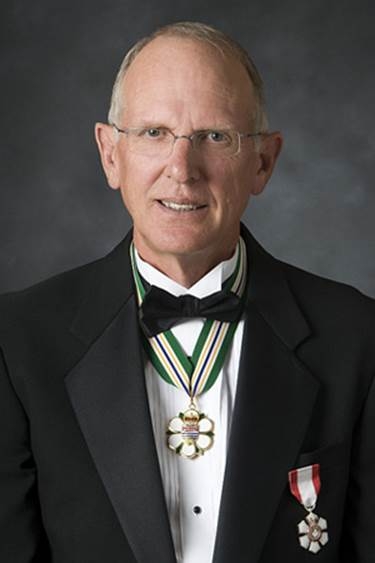Legendary coach calls for CIS improvement
Posted on April 16, 2015
Ken Shields discusses the state of Canadian university sport

Head coach Ken Shields, centre, celebrates one of seven CIS titles with the University of Victoria Vikes. He wants CIS basketball to return to the competitive standard that his Vikes team set from 1976 to 1989.
By Gilbert Coyle, Sports Editor
Ken Shields knows what it takes to develop Canadian basketball players.
The four-time Canadian Interuniversity Sport Coach of the Year won seven straight national championships with the Victoria Vikes men’s basketball team from 1980 to 1986, coached the Canadian men’s national team from 1990 to 1994, helped out the Australian national team at the 2004 Summer Olympics and was a guest coach with the NBA’s Milwaukee Bucks in 2006.
In 1998, he was named as a Member of the Order of Canada for his contribution to Canadian basketball.
But Shields is most proud of how he turned dozens of Canadian university basketball players into international-calibre athletes. Especially because these days, he thinks the CIS is declining without the resources to keep top athletes in the country.
Shields is currently part of a panel set up by Own the Podium to address the CIS’ declining role in competitive Canadian sport. Specifically, the group focuses on curbing Canada’s escalating “athlete drain” to the U.S.
In a discussion paper released in Jan. 13, the panel reported that over 2,000 Canadian athletes aged 18 to 23 joined the NCAA between 2008 and 2010. With top student-athletes consistently heading over the border, national teams that are traditionally dependent on CIS athletes are finding fewer international-level performers in Canada.
Under the direction of the federal government’s Minister of Sport, Bal Gosal, the panel developed a CIS High Performance Program Concept with two fundamental objectives — to retain Canada’s top student-athletes through development programs within Canadian universities, and to improve Canada’s international performances in selected sports while depending on Canadian universities for athletes.
On Tuesday, Shields shared his thoughts on the current state of CIS basketball with the Journal.
What are your major concerns with CIS men’s basketball right now?
The biggest thing is that 88 of our very best players don’t play in Canada, and this is just the number in Division One schools. It’s reflected in the number of players that will play for Canada. Our national team is made up of all out-of-country players, there’s been a precipitous drop-off of CIS players on our national teams.
In the 1984 Olympics, out of 24 players [on the men’s and women’s basketball teams], 14 were CIS-trained, both teams finished fourth in the Olympics, the standard of play was high … Last year, at the World Qualifying Championships, the men’s team had one — Aaron Doornekamp. In my view, this is a very serious problem.
Can the CIS compete with the NCAA for top Canadian basketball players?

Ken Shields was made a Member of the Order of Canada in 1998.
[It can] if it focuses on athlete development. We need … a development program that will give you a better chance to develop your maximum potential than the NCAA, because the NCAA is hugely restricted in contact hours with the coach. There are limits to the number of hours you can have contact with an athlete. In the summer, it’s two hours per week. The focus can’t be in the gym with the athletes — coaches can’t go in the gym, they can’t do individual work.
The NCAA isn’t trying to develop players to maximum because restrictions don’t allow it. So, why we don’t have a better development opportunity in Canada? We need to have a better-developed system and a better-funded system in our own country in select CIS sports. Unless you have comparable or better programs, the athletes will choose to leave our country.
The top basketball players go to the U.S. before they even finish high school. Is that the CIS’s fault?
I can speak for British Columbia, where there has been a great erosion in high school basketball because of fewer teacher-coaches. Across the country, coaching-development programs have slipped. Most of our basketball is played in the school system and yet we don’t have a systematic way to train coaches, which are the lifeblood of the system.
Steve Nash played high school basketball in Victoria, B.C. Was high school basketball’s structure better back then?
It was better, but the erosion had started in the school system. Steve was fortunate he went to [St. Michael’s University School]. Ian Hyde-Lay coached there, he was a bright young coach who had played for the Vikes for his five years, he was a very knowledgeable basketball man. Steve actually started in the public system, but he moved to St. Mike’s because his Dad wasn’t pleased with his attendance record. How can youth basketball improve?
I would like to see every university run an academy like [Carleton Ravens coach Dave Smart] does. He runs a Ravens club program that’s basically a development academy for youth in that area. You have to have your best players in an academy to lay the foundation for development.
Is it the really CIS’s job to keep Canadian basketball competitive?
In the 1990s, when our top academic scholars were being picked off by large U.S. universities, the federal government and university associations got together and developed programs … to stop the “brain drain.”
In October, Prime Minister Harper announced that the ‘brain drain’ had been reversed because they put scholarship programs and research money to keep these top academics in Canada because the universities were losing the top students.
Just as we have A-level students we have A-level athletes, and our A-level athletes are being drained away to the States. The problem should be addressed, not just in basketball, but across all CIS sports … When people who go to the states, huge percentage stay there, and don’t come back.
How can the CIS even begin to achieve this vision?
That’s going to take a partnership between all of the sports agencies in the country. Basketball Canada would have to be involved, Basketball Ontario, the national body, Own the Podium … a collaborative effort designed to keep our best athletes at home and then provide them with the training, the competitive experience and coaching. The positive part is that there has been this working group, including CIS leadership, looking at the issue.
Does the CIS have the depth to specialize?
Universities don’t run PhD programs in every discipline — they pick where their strengths are and they focus their resources. I’m hopeful that universities across the country will want to do this so that a high-performance structure can be formed to allow institutions to pursue international standards, because right now it’s impossible. Financial rules are the main things that preclude it.
In 1984, we had 25 [University of Victoria] students and coaches at the Montreal Olympics because we focused our resources on a select number of sports. There’s no question that it can be done.
How did your Victoria Vikes teams do so well against NCAA opposition when you coached them from 1976-89?
We played mid-level Division One schools, we didn’t play the very, very elite … When we played Oregon State, they had won [their conference] … We didn’t get blown out, we lost by 14 or 15. But we had a .500 record against NCAA teams on the road, so we were very proud of that … we showed that our university could go down with Canadian players and compete with mid-level NCAA teams.
What about the seven straight national championships?
They were nice, but they came as a result of trying to do those other things. Our goal was to put players on the national team, and we helped more players do that than any other university. Athletes, when they graduate, should have had the opportunity to have developed to the highest level possible — that means international standards of performance.
Right now, we’re calling excellence the CIS championships. But they’re not excellence in my view. How can you have it if the top men aren’t here? National excellence would be international standards of performance.

